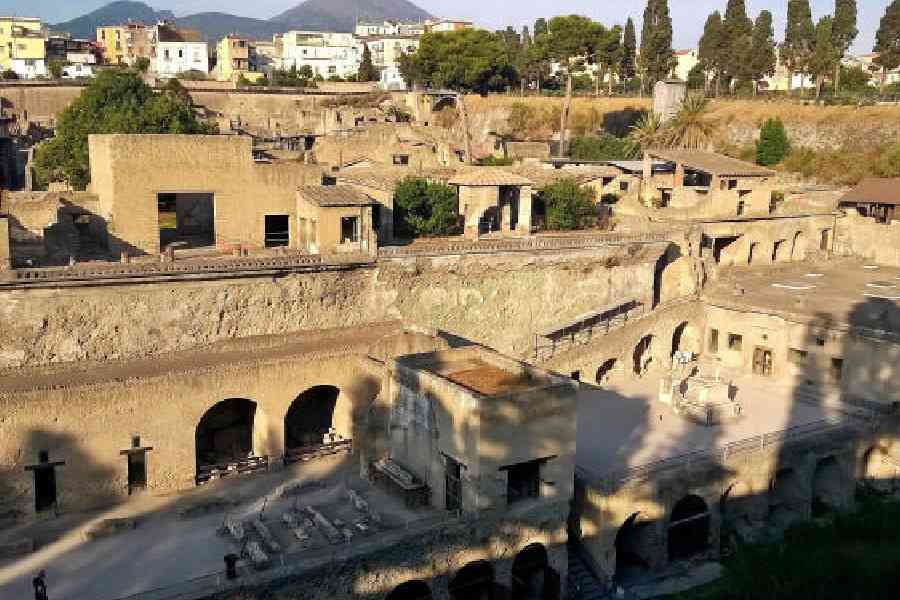When Mount Vesuvius erupted in AD 79, fiery avalanches of ash and pumice assaulted Pompeii, displacing some 15,000 inhabitants and killing at least 1,500 more. Volcanic debris “poured across the land”, wrote the Roman lawyer Pliny the Younger, and blanketed the town in a darkness “like the black of closed and unlighted rooms”. Within two days Pompeii had vanished, leaving little more than a legend until 1748, when the chance discovery of a water line prompted the first deliberate excavation.
In his late-18th-century travelogue Italian Journey, Goethe observed that no calamity in history had given greater entertainment to posterity than the eruption that had buried Pompeii. For scholars and armchair archaeologists, that entertainment has involved wrangling over pretty much every facet of the disaster. They still can’t agree on the day Vesuvius blew its top, the height of the umbrella-shaped cloud or the length and the aggression of the blasts. Two new research projects add kindling to those embers.
A report published by the Archaeological Park of Pompeii resurrected the once widely accepted belief that the cataclysm began to unfold on August 24, the date put forward by Pliny, who was 17 when he witnessed the event from a villa across the Bay of Naples. His letters to the historian Tacitus, written more than 25 years after the fact, are the only surviving firsthand account and the only documents that offer a precise date.
We no longer have the original letters, only translations and transcriptions of copies, the first of which was made in the fifth century AD “Many manuscripts of Pliny’s letters came down to us with differing dates,” said the classicist Daisy Dunn. Her 2019 biography of Pliny, The Shadow of Vesuvius, is the definitive guide to him and his uncle, the naturalist Pliny the Elder, who died during the eruption. “August 24 was chosen as the most secure on textual grounds,” Dr Dunn said.
In sticking by Pliny, the park walked back some of the recent enthusiasm for October 24 as a possible start date for the eruption, a theory that had been fueled by the 2018 discovery of a scrap of graffiti on a wall of the site’s freshly excavated House of the Garden. The charcoal scrawl records a date that translates to October 17 in the modern calendar, suggesting that the eruption might have occurred after this time. The find, which did not specify a year, seemed to corroborate other unearthed clues that pointed to cooler weather than is typical in August: remnants of unripe autumnal fruits such as chestnuts and pomegranates; heavy wool clothing found on bodies; wine in sealed jars, indicating that the grape harvest was over; and wood-burning braziers in homes.
Massimo Osanna, general director of the park at the time of the discovery, was convinced that the graffiti was idly doodled a week before the explosion. “This spectacular find finally allows us to date, with confidence, the disaster,” he said. Dr Dunn found it improbable that Pliny would have forgotten such a momentous date.
The park’s recent about-face from October to August relied in part on a forensic analysis of Pliny’s letters by Pedar Foss, a classicist at DePauw University in Indiana. For his 2022 book, Pliny and the Eruption of Vesuvius, Dr Foss examined 79 early hand-copied manuscripts of the letters and mapped out how textural errors had been compounded. He concluded that a simple scribal mistake, made in the 1420s, of switching a “u” for an “n” had resulted in an incorrect eruption date of November 1. The error appeared in the second print edition of Pliny’s letters, in 1474, and gave rise to further misreadings, misunderstandings and misuses.
By the 20th century, seven different possibilities were in circulation — eight, counting November 9, which Mark Twain casually proposed in Innocents Abroad, his 1869 travel narrative. “Those many options gave the appearance of doubt concerning what Pliny actually wrote but, upon examination, I was able to explain away each of the mistaken alternatives,” Dr Foss said.
He also explained away each of the archaeological alternatives to August 24, some of which he believes fail based on the evidence; some, on the basis of faulty reasoning. He argued that the pomegranate rinds were used for dyeing, not eating; that the Romans commonly used braziers for cooking, not just heating; that wool clothing was standard gear for Roman firefighters; and that Roman agricultural and storage practices allowed for the preservation of fruits beyond their natural harvest seasons.
As for the House of the Garden doodle, on October 12, 2023, researchers commissioned by Dr Osanna’s successor, Gabriel Zuchtriegel, left their own message on the same wall on which the graffito appeared. Ten months later — on August 24, 2024 — the text was still perfectly legible.
Claudio Scarpati, a volcanologist at the University of Naples Federico II, favours the traditional date. “In my mind, the eruption occurred in August, on a sunny day,” he said. Dr Scarpati is the lead author of two recent studies published in The Journal of the Geological Society. One offered an hour-by-hour reconstruction, extending the chronology from the previously estimated 19 hours to 32 hours. The other revealed a dynamic sequence with 17 distinct “pyroclastic density currents”.
New York Times News Service











